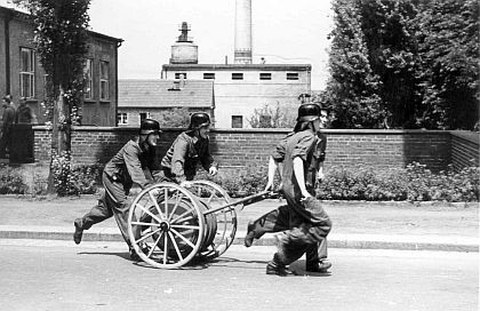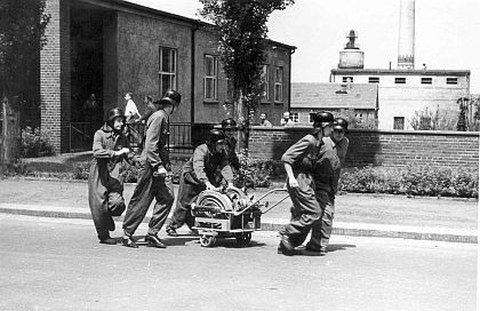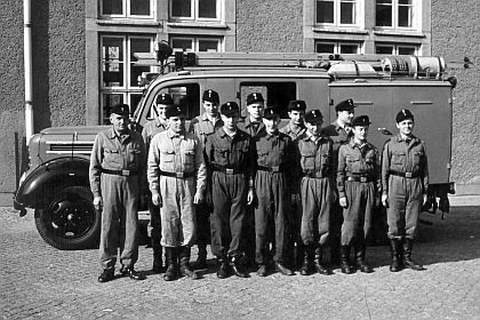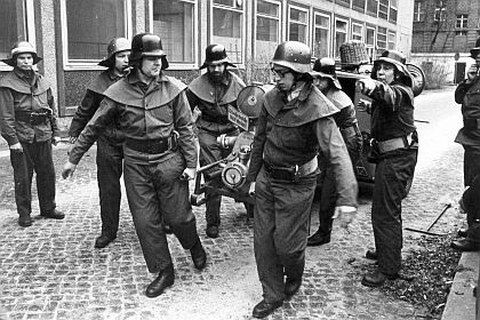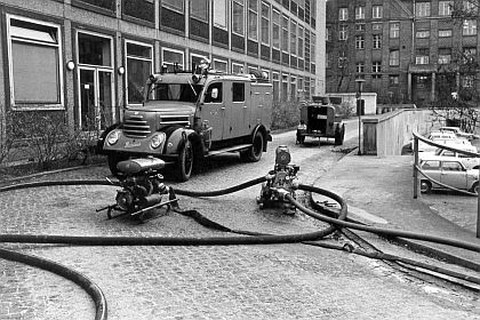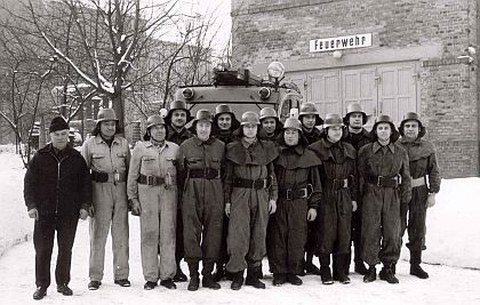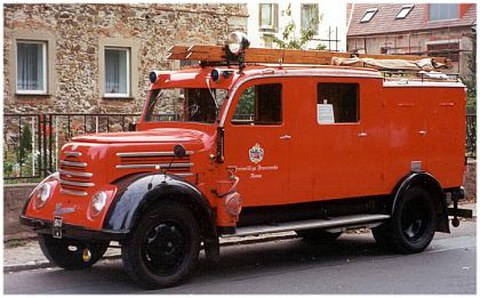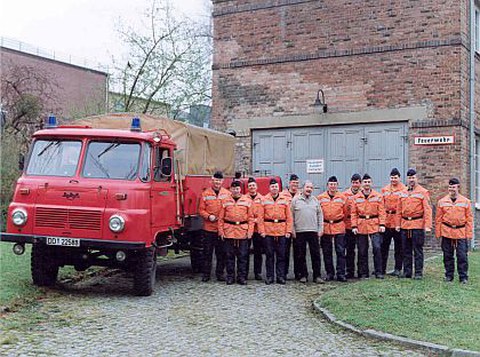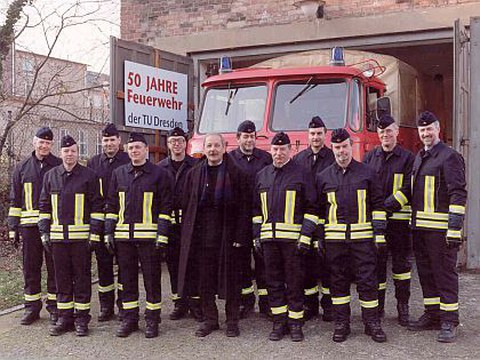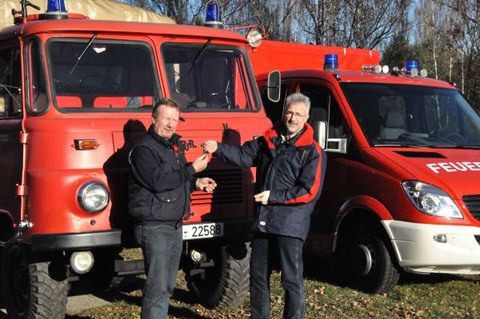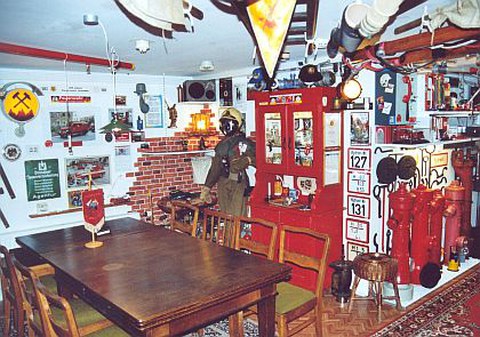History
The history of the Volunteer Fire Brigade at TU Dresden
In 1952, TU Dresden (known as Technische Hochschule Dresden back then) was considering forming its own fire-fighting crew. After a staff survey was conducted, 32 volunteers stepped forward in May of the same year. They began their basic training in the same month, when they were split into three groups and trained during work hours.
Horst Beer and Eckard Rost were among the first to volunteer. They were instrumental in the establishment of the Volunteer Fire Brigade and remained dedicated to it for decades. The first major fire drill took place in July 1952 at the Beyer-Bau building and the garden at Mommsenstraße / Bergstraße witnessed the first alarm drill. The alarm was still sounded by telephone until a siren was installed on the roof of the cogeneration plant, where it is still located today. The siren could be triggered from the Betriebswache (security corps) building, formerly known as Betriebsschutz (industrial safety).
The team built their first equipment themselves, including a hose cart, equipment carrier with a hydrant wrench and a standpipe.
Both were propelled manually. They got their first TS8 portable pump in 1956, and had a 20 meter turnable ladder for a while. On the basis of the Fire Protection Law, the university’s Fire Brigade continued to expand its activities and trained in effective firefighting on a regular basis. Group leaders, equipment operators and chainsaw operators were also trained in courses at the city’s professional fire department and the forestry department. Training for fire brigade captains was held in the Dresden-Löbtau fire station.
In 1958, an apparatus bay and dorm space were built into the Betriebsschutz building. In this same year, the university’s Fire Brigade was able to house their first fire engine there, a GARANT 30K with a pump and hose trailer. During the reconstruction of the Georg-Schumann-Bau building in 1965, the Fire Brigade was provided with a hose tower, where they have washed, inspected, dried and stored their hoses ever since. The pump and hose trailer is housed in a small garage behind the Jante-Bau building.
The GARANT 30K was in service for over 24 years, ultimately being replaced in 1982 with a brand new Robur LO 2002 A with a pump and hose trailer from a fire engine production plant in Görlitz. Fortunately, the decommissioned GARANT avoided the scrap heap and is still lovingly cared for at the Sächsisches Feuerwehrmuseum (Fire Brigade Museum of Saxony) in Zeithain, close to Riesa.
After the Fall of the Berlin Wall in 1989, the future of the TU Dresden’s Fire Brigade remained uncertain for a long time. There were not many examples of Fire Brigades at the other German universities. Many members left the Fire Brigade due to restructuring or because they moved away. As a result, the former staff of about 20 members was almost halved.
It is largely thanks to the former Head of the Safety at Work Unit, Wolfgang Kühn, and the Captain of the Fire Brigade, Harald Wolf, that the Fire Brigade still exists today. With a great deal of skill, commitment and sound judgment, they once again gave the Fire Brigade a solid foundation to meet the demands of the new era. In 1996, Klaus Liebich took over as Captain.
During the catastrophic floods of 2002, the Fire Brigade sprang to action and provided assistance in many areas. After this, they were able to renew some of their equipment once again. They purchased a new TS 8 portable pump, an electric generator and a wastewater pump. The members also received new uniforms. In the years following the flooding, the calls for a new fire engine grew louder. The trusty “LO” had always served us well, but after almost 30 years of service, it no longer quite met the technical requirements of the day.
In cooperation with the Unit for Safety at Work, a new Fire Brigade and emergency management strategy for TU Dresden was developed in 2010. We were able to welcome many more members during this time. In addition to the reorganization, we also created this website. Thanks to the support of the former Chancellor of TU Dresden, Wolf-Eckhard Wormser, we acquired a new fire engine in the autumn of 2011. The Mercedes-Benz Sprinter 516 C was equipped specifically to meet the requirements of our university. This involved a new approach. In addition to a 6:1 crew cab, the vehicle was fitted with a cargo area with an arched frame and tarpaulin cover as well as a tail lift. The equipment is stored in a shelf at the front and in 4 storage trolleys, ensuring the vehicle’s versatility. In November 2011, we handed our long-serving “LO” over to the loving care of the Fire Brigade Museum in Riesa/Zeithain.
The new vehicle and acquisition of modern equipment allowed us once again to welcome many new members to the Fire Brigade. We can draw on a wealth of experience, especially from our student members who come from all over Germany and all have sound experience in firefighting. We now have around 25 members, half of whom are students, so the average age of our Brigade currently lies in the mid-thirties. This means that in terms of space, we are fully maxed out for the time being.
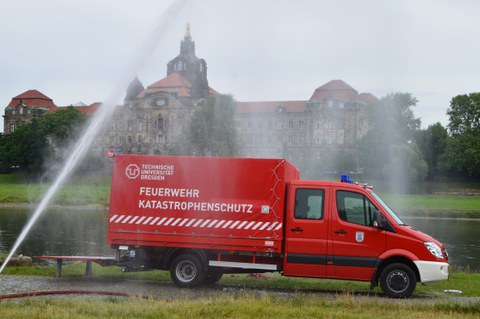
The fire engine of TU Dresden’s Fire Brigade by the Elbe
We also remain active in public relations work to the extent possible. We organize a morning on fire brigades and fire safety at our partner kindergarten once per year. We also present our work during the Dresden Science Night and participate in events on the topic of fire brigades in local area. We are also members of the Stadtfeuerwehrverband (City Fire Brigade Association) of the City of Dresden and maintain good contacts with the various district fire departments throughout Dresden. In the summer of 2012, we celebrated our 60th anniversary with a small ceremony. An old friend of our Fire Brigade, Mr. Thilo Stahn, took the anniversary as an opportunity to gift us a banner with an original 1952 design. The banner was presented to our captain by Mr. Rümpel, the head of the Brand- und Katastrophenschutzamt Dresden (Fire and Disaster Protection Office Dresden), and Mr. Hofmann, head of the Stadtfeuerwehrverband (City Fire Brigade Association), at the City Fire Brigade Association meeting in spring 2013. The banner was presented publicly for the first time during the 4th Saint Florian’s Day parade celebrating 150 years of the Fire Brigade in Dresden.
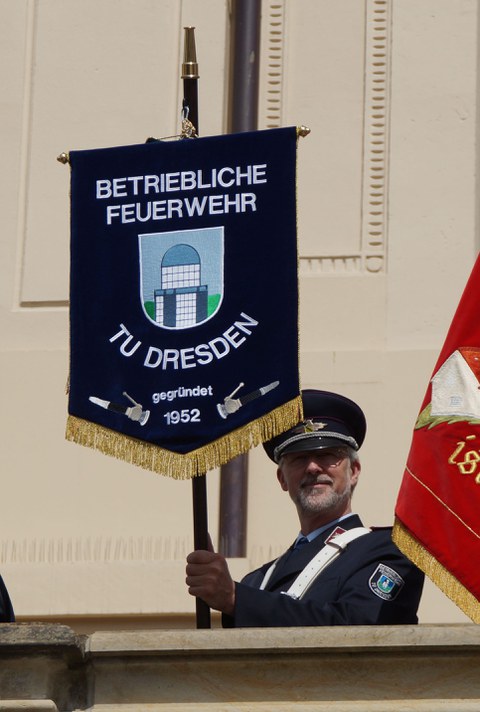
Our traditional banner
We were of course also called into action during the 2013 floods, during which we could benefit from the advantages of our new strategy for the first time. In addition to operations in which our firefighting equipment was needed, we also transported sandbags after a quick refitting and distributed relief supplies and donations to kindergartens around Dresden. Since then, we have acquired radio equipment to improve communication during operations. In recent years, there has also been calls to reintroduce respiratory protective equipment, especially for safe reconnaissance. It had been phased out in the ’90s due to a shortage of availability and also due to financial reasons, as the old equipment from the times of the German Democratic Republic had to be completely replaced. We have now been able to acquire this equipment again, not least because we also have a number of members who are qualified to work with respiratory equipment. To ensure the safe use of the respiratory protection equipment, a member of our team also successfully completed the Beauftragter Atemschutz (Respiratory Protection Officer) training this year. We store four sets of the respiratory protection equipment in a special storage trolley in our vehicle. Another four replacement sets are housed in our apparatus bay. Our next major purchase is likely to be the procurement of a new vehicle (a medium pumper fire engine). We are working on a plan for this at the moment.
Today, the university Fire Brigade is still alerted via the siren, additionally via landlines and of course via cell phone.
You can visit a small exhibition with interesting artifacts on the history of fire protection in Dresden and specifically at TU Dresden in the Fire Brigade’s Heritage and Exhibition Room. Contact: Klaus Liebich, member of the Volunteer Fire Brigade at TU Dresden

